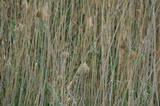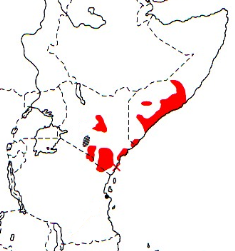Weaver species
Choose different species from drop-down list and press 'Go' button. See Full species list.Fire-fronted Bishop Euplectes diadematus
IUCN: Least concern Discovery: 073Categories: black and yellow bishops,
News items about species
Discovery
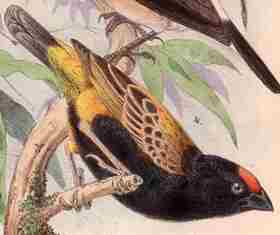
figure from Fischer (1879) 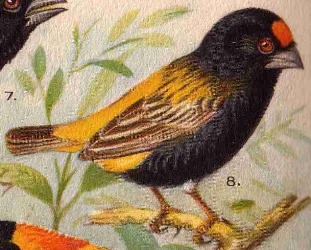
figure from Delacour (1933) 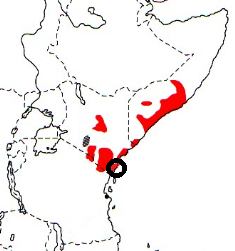
distribution, type locality circled IntroductionThe Fire-fronted Bishop was formally described by Anton Reichenow, a German ornithologist and herpetologist. He was curator of the Humboldt Museum in Berlin and described many birds, as well as some frogs and lizards. The Fire-fronted Bishop was collected by Gustav A Fischer, a German African explorer. In 1876 he accompanied Clemens Denhardt's expedition to Zanzibar, where he settled as a physician. Fischer collected some birds in Zanzibar and then undertook a trip along the Kenyan coast where he collected some Fire-fronted Bishops.The first illustration of the Fire-fronted Bishop was published in Fischer (1879). The second illustration was published much later, by Delacour (1933), also of a male. The first female was illustrated in Mackworth (1955). Scientific citationEuplectes diadematus Fischer & Reichenow 1878 Orn. Centralbl., 3, p.88 Malindi, Kenya.Meaning of namesdiadematus, Latin: diadematus, diademed, adorned with a diadem.First English nameFire-fronted Bishop-bird (Shelley 1905).Alternate namesNone.CollectorGustav A Fischer.Date collected4 Sep 1877.Locality collectedMalindi, Kenya.Type specimensA type specimen is in the Berlin Museum (ZMB_23367) and there are some other syntypes. |
The above is based on Weaver Wednesday 2, a weekly series about the discovery of each weaver species.
This species text first appeared as
Weaver Wednesday [190] - Discovery [73]: Fire-fronted Bishop on 2016-02-03
1. Basic biology
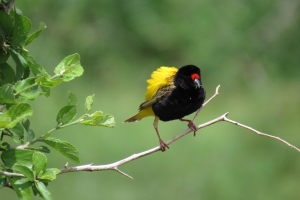
Queleas also have yellow-edged wing feathers, but the female Cardinal Quelea has a heavier bill, bolder markings on the upperparts, and a yellowish throat; the female and non-breeding male Red-headed Quelea is larger-billed, with dark moustachial marks and a yellow superciliary stripe. The Fire-fronted Bishop is much smaller than any other weavers with yellow-edged wing feathers. Distribution. The Fire-fronted Bishop occurs in Kenya, Somalia and north-eastern Tanzania (see map below, based on Birds of Africa). No races are recognised. Habitat.
The Fire-fronted Bishop inhabits open grassland and cultivation, as well as bushed coastal dunes, rice fields and temporary swamps. It is nomadic, making large movements in response to rainfall. It does not form large flocks, but may associate with weavers and queleas in feeding flocks or at roosts.
Food. The Fire-fronted Bishop feeds mostly on grass seeds such as those of Sporobolus and Echinochloa. While breeding, it also eats termites and spiders. It forages in small groups. Breeding. The Fire-fronted Bishop is probably polygynous. It is territorial, and breeds singly or in small colonies of 8-12 males. The male displays with head bowed, body plumage fluffed out, and he bobs up and down, rapidly flicking his wings. The nest is a round structure with a slight porch, and a large side entrance near the top. The nest is loosely woven of grass stems and grass blades, and lined with softer grass. Some nests are so loosely woven that the eggs can be seen through the side of the nest. The nest is attached to grass stems or twigs of small shrubs growing in grass clumps. The female may contribute to nest building, and continues to add lining during incubation. The eggs are pale blue, lightly speckled and spotted with black and grey-black markings. |
The above is based on Weaver Wednesday, a weekly series about weaver species.
This species text first appeared as
Weaver Wednesday [94]: Fire-fronted Bishop on 2014-04-02
2. Breeding facts
| Pair bond probably polygynous Breeding season Aug-Sept in Somalia; May-Jun, also Dec-Jan following rain, in Kenya Nest site attached within 0.5 m of ground to grass or herbs in grass clump Nest building female may contribute to building Colony size nesting solitarily or in colonies with up to twelve males Clutch size 2-5 eggs Egg colour pale blue, lightly blotched and spotted with black Egg size average size of ten eggs 16.5 x 12.5 mm (Kenya) Incubation in captivity,incubation by female, period 10-12 days Chicks and nestling period nestling period 11-12 days |
Breeding information based on Handbook of the Birds of the World, Vol. 15.
3. Photos of Weaver Nests
No records yet - be the first to submit a PHOWN record!See PHOWN summary page for this species here.
PHOWN (Photos of Weaver Nests) provides valuable info on breeding distribution and colony sizes of weavers.
You can contribute by registering and submitting photos at Virtual Museum webpage.
4. Breeding distribution
Google map showing distribution (For species with small ranges you need to zoom in at the correct area to see the range):
yellow blob - range of weaver species; read more about this here.
![]() - PHOWN records with photos
- PHOWN records with photos
![]() - PHOWN records with no photos (Nest Record Cards, other records)
- PHOWN records with no photos (Nest Record Cards, other records)
![]() - Birdpix records
- Birdpix records
![]() - comments on out of range records, or interesting records
- comments on out of range records, or interesting records
![]() - type locality
- type locality
CLICK on the marker on the map to see individual record details.
5. Range changes
Not South African speciesThe above is based on Weaver Wednesday 3, a weekly series about range changes in South African weaver species.
This species text first appeared as
n/a








